#fresnel glass
Text
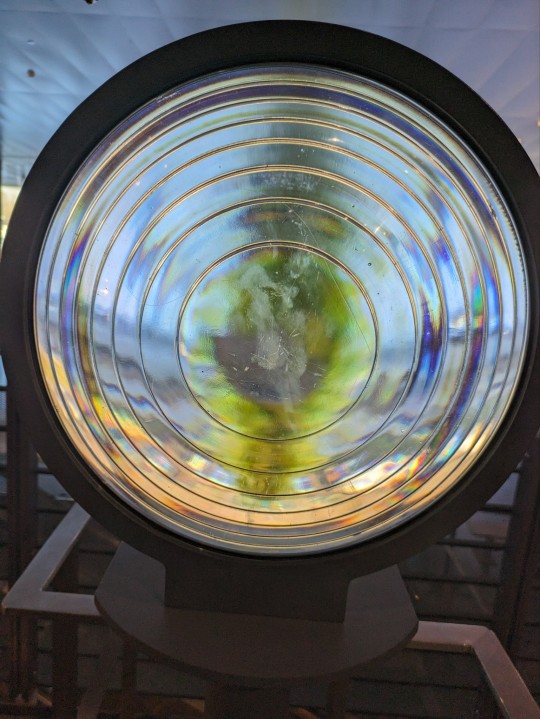
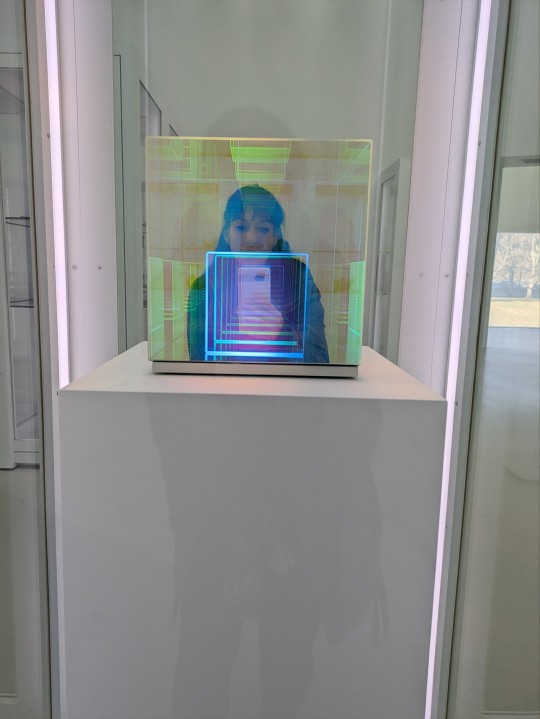


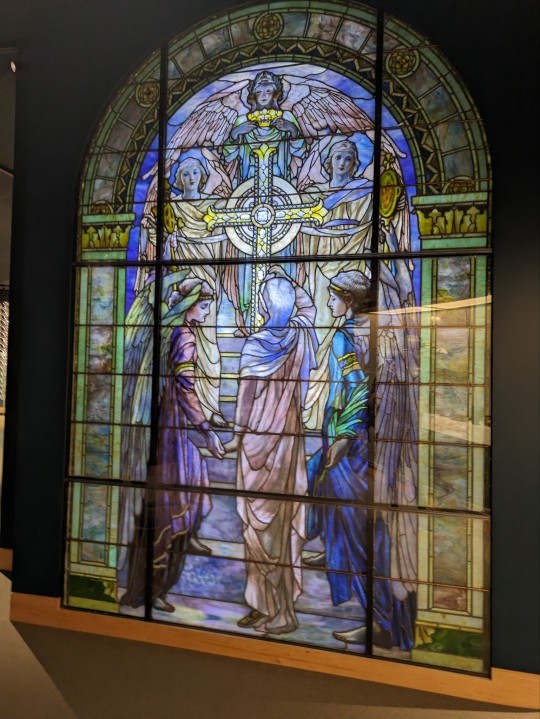

I went to a glass museum today it was pretty sick ☄️🍶🪩💎🔎🔮🗻🎐
#glass#corning museum of glass#museum#art#sculpture#stained glass#fresnel glass#vintage#antique#pictures#images#me#mine#new york#new york state#ny state#western ny#western new york
69 notes
·
View notes
Text

if anyone was curious about my inspirations
#memories like glass#also yea thats a human fresnel design#ralph plainview#...if i get anxious ill untag ralph#theres a lotta specific inspos for memories like glass and i hope i get to share them all one day#object oc#pt draws
2 notes
·
View notes
Text

Two red port lanterns with Fresnel glass reflectors, 19th century
131 notes
·
View notes
Text

Mission Point Lighthouse, Old Mission Peninsula, Traverse City, MI. August 5, 2019.
“To be a lighthouse, you must be strong enough to resist every kind of storm, to every kind of loneliness and you must have a powerful light inside you!”
— Mehmet Murat Ildan
Her guiding light first graced the tip of the Old Mission Peninsula on September 10, 1870. Using a Fresnel Lens — made of many small pieces of glass, with different thicknesses to reflect and magnify light — her comforting lamp illuminated the dangerous waters of the north end of west Grand Traverse Bay.


Cared for by only seven lightkeepers through the decades, she was finally decommissioned in 1933 and replaced by an automated-offshore buoy light.
Her story is now a testament to the beautiful history of the many lighthouses on the Great Lakes.
As a side note, I highly recommend traveling along the scenic Peninsula Dr and stopping at the Jolly Pumpkin Brewery. I can personally attest that their dark ale is a perfect addition to any pizza & beer day (aka Friday). 😋😎
By @aviationgeek71
#lighthouses#great lakes#my photography#my photos#my writing#original writing#original photographers#black and white photography
51 notes
·
View notes
Text
The Custom CubeMaps for TS2 Post
You may know that the Sims 2 uses cubemaps to add a reflective effect to certain objects/materials. The details of this are explained in Part 2 of Pixelhate’s ‘Exploring the TXMT’ series.
This document also explains how to make a custom one... but the result is not functional, at least in my all-EPs, all-SPs game. Fortunately, there’s an easy fix:

‘EnvCubes’ are not regular texture images. They contain six different “blocks”/subtextures, one for each side of the cubemap. Thus creating a custom EnvCube involves extracting and renaming one of Maxis’, and replacing the various subtextures.
(Unlike SpecularMasks, these don’t mind the DXT1/3/5 formats. Error messages may appear if you import a texture bigger than the existing ones, though. In that case, commit and close the ressource, save the package, and open the ressource again.)
So TL;DR, I made a bunch!

I also made a test object for ease of visualization. Here, it demonstrates Maxis’ “reflectioncubetemplate-envcube” texture with the material’s “stdMatEnvCubeLockedToCamera” parameter set to zero and one respectively. More on that later.
The materials in the following pictures generally have an“stdMatEnvCubeCoef“ parameter of 0.5, 0.5, 0.5; its base texture is flat black.
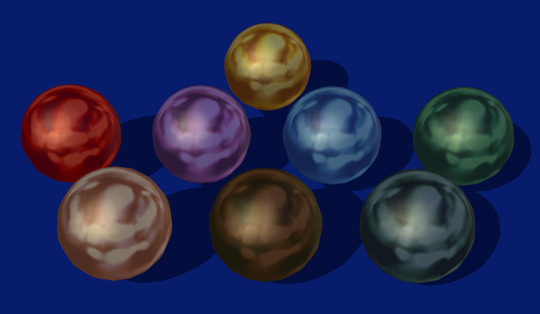
My first creations: extra recolours of the texture used by most of the game’s metallic cubemaps. The top ball shows Maxis’ “reflectiongold” envcube as a point of comparison.
The middle row contains “MetallicRed”, “MetallicPurple”, “MetallicBlue” and “MetallicGreen”.
The bottom row contains “RoseGold”, “MetallicBrown” and “Gunmetal”.

I’ve also made variations of Maxis’ “reflectionsparking” cubemap (visible left), often used for glass and plastic. The middle texture is “HighContrastSparkling”; the one on the right is “SparseHighlights”.
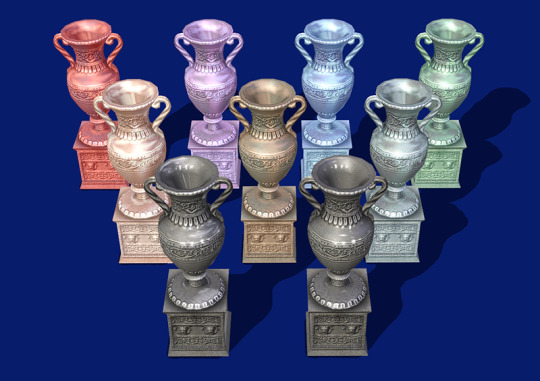
The same custom envcube, previewed on the urn sculpture. Probably not their best look, tbh.
Now for something quite cool:

With specific textures and the “stdMatEnvCubeLockedToCamera” parameter set to 1, we can achieve a rimlit and/or holographic effect! Here are “RainbowFresnel”, “HoloFresnel” and “Fresnel”.

The spheres don’t really do this effect justice. So here is a demonstration of their “cool holo fabric” potential, gif included. Hopefully no one beats me to making a holo skirt haha.
(+ my two reflectionsparking edits on the sides. )

I’ve also fixed up Pixelhate’s own custom envcube, though their texture turned out not to be ideal.
-
My test object and all the pictured recolours can be downloaded here on SimFileShare.
The tester is found under Deco/Misc for 1$. The actual envcube textures are found in its various recolour files, but are only referenced by the recolours of other objects. This means that if you delete “EnvcubeTester_recHoloFresnel”, “HnMManequinLongDress_RecHoloEnvCubeLocked“ won’t be able to find the texture it’s supposed to use.
And here is a zip containing these envcubes as individual TXTR ressources ready to be imported into SimPe, as well as a package file containing all of them.
Again, Pixelhate’s documentation explains how to actually use these custom envcubes for your own CC. My last package file can be used as a “pseudo texture repository” as described in their guide.
-
And a few last minute tips for creators:
The projected envcube is additively added to the object’s main texture and shading. Its brightness is also dependant on the ambiant lighting, being much duller inside. This means that a dark envcube texture likely won’t have much effect.
Maxis’ cubemap projection is weird. Some of the textures don’t have the orientation you’d expect. I’d recommend extracting the subtextures from “reflectioncubetemplate” and testing out your envcube on my test object if you’re strugging with that.
Making a ‘rimlit’ cubemap only involves creating three textures: ‘back’, ‘front’, and a gradient between those that will be reused by all sides. See my ‘fresnel’ envcubes as a reference.
When using such a ‘rimlit’ envcube, don’t forget to set the “stdMatEnvCubeLockedToCamera” parameter in the material to 1. It won’t look too good otherwise :p
Custom EnvCubes can also be used for clothing and other CaS items with the “SimStandardMaterial”. However, they are a bit pricklier: “##0x1C050000!” has to be added before the texture name in the “stdMatEnvCubeTextureName” parameter. It won’t work if this extra string is not present.
103 notes
·
View notes
Note
tell me about french train headlights
They're all the same! Or at least they were, from the mid-1950s to about the early 1990s. They all look like this:
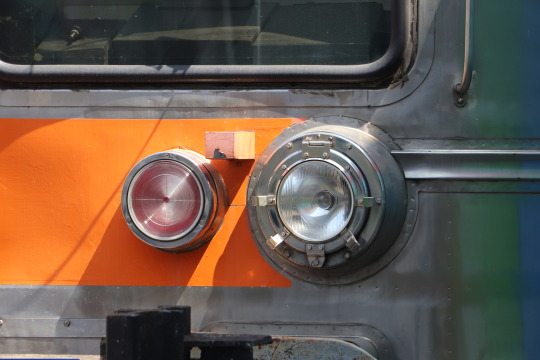
Okay, some context for why I find this interesting. Suppose you see a picture of a train, especially one made in the second half of the 20th century, and you want to know where the train is from. The key trick to telling this at a glance is having a bit of autism, but more specifically, the headlights.
In Europe, all major and many minor countries used to have their own government-owned railroad and their own train-building industry, which would build trains to the specifications of their railroad company. There has always been some exporting going on, but for the most part, the trains you'd find in Germany, France, Switzerland, Austria and so on would be all completely different. This has changed drastically over the past 20ish years.
One thing about this old model is that railroad companies would standardise certain parts within their fleets, especially small parts that need servicing and replacing every now and then. It saves on how many different types of spare parts you need to have.
Headlights are the most notable among these by far: Every train needs to have some of them. All trains have basically the same requirements for their headlights, no matter how fast or slow or whatever they are. Before LEDs, you needed to service the headlights regularly to replace the light bulbs, and as glass parts at the front of a fast moving vehicle, they can get damaged, so spare parts logistics are an issue. And most importantly, we as railfans can easily see them. So you get something like this:
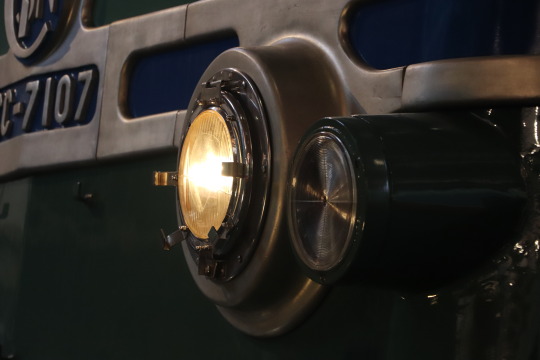


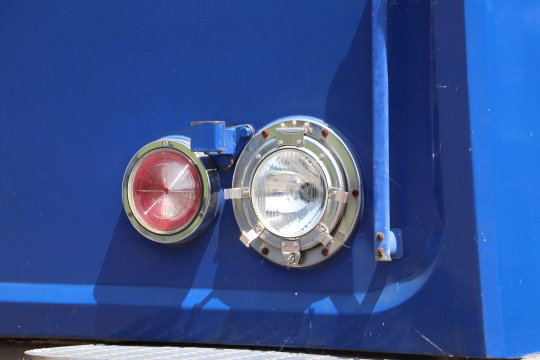
As a result, basically all railroad companies in post-war Europe standardised their head- and taillights for all or most of their trains. And all of them had completely different ideas. Fundamentally, all of them agreed that you need white headlights and red taillights, and since modern trains are easily reversible, you put both of them next to each other.
But do you make the white and red lights the same size (West Germany, Netherlands) or different sizes (Austria, East Germany)? Are they separate things, or do you combine them into one assembly (UK, Switzerland)? Do you make them anything approaching normal sized or gigantic (Poland)? Maybe I'll do an overview post over these later, but I don't have enough pictures in my library right now and I'd have to scour Wikipedia for them later.
The French headlight design shown here is in many ways just one of many, but also interesting in its own right: The actual lenses for red and white are the same size, but the white headlight gets this huge lens assembly that makes it look much more prominent. You can clearly see that different French designers had very different ideas about whether you the center-lines (most of them), or the bottom of the lens assembly. Why is the headlight lens so big, and what are the metal was around the bottom half of the circle? I have no clue. My guess is to put some coloured glass panes in, but I have no idea why you'd need that. Also, note that the red taillight classically has a fresnel lens, that's unique as far as I can tell.
I've taken all these pictures in the Cité du Train, the big central French railroad museum in Mulhouse. (That's why I was posting about traveling to Basel early this weekend. Mulhouse is actually really close to Basel, and going via Switzerland is the most practical—and most scenic—route for me) The oldest locomotive I could find with these headlights was CC-7107:

During high speed trails in the early 1950s, this locomotive reached a speed of 326 km/h (203 mph). That made it only second best behind the other locomotive at the trials, BB-9004:

This one reached 331 km/h (206 mph), a world record that would not be beaten for a long time. The difference was nothing to do with technical performance. Instead, both locomotives melted their pantograph, the part on top that touches the overhead line to get power, at around 320 km/h (200 mph). BB-9004 had a second one that it could lift up to continue accelerating, while CC-7107 only had the one. For a long time, SNCF pretended that both locomotives had reached 331 km/h, to protect the reputation of both manufacturers.
What's notable for our purposes is that BB-9004 has different headlights. As far as I can tell, these seem to be an earlier standard design, also found e.g. on the CC-65001 diesel locomotive:
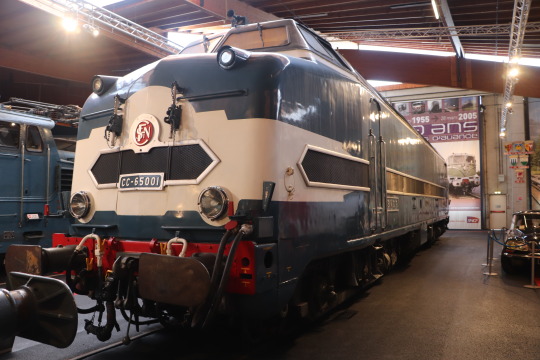
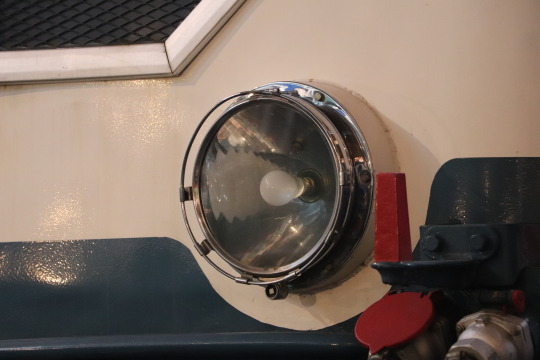
And even on steam locomotives, like this class 141 R:

So CC-7107 lost on the high speed world record, but it was the way of the future when it came to headlights. These headlights then started cropping up everywhere. From the detail pictures I've shown you above, we have e.g. Le Petit Gris (the small grey one, an EMU for suburban services in Paris):

A CC-6500, dressed up with a nameplate for the express train it was hauling. Fun fact: One locomotive of this type (not this one) was used in the US for a while, as Amtrak was trying out new electric locomotives to use. They weren't happy with it and bought a Swedish one instead, mostly because this locomotive's suspension did not work well with the American track quality.
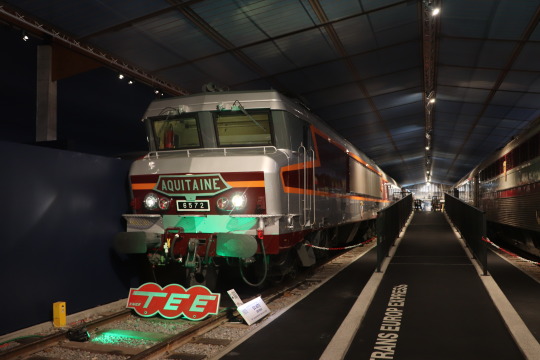
A Z 2200, a diesel railcar for rural lines designed to be cheap first, second and third.

A BB-26000, which feels altogether way to new to be in this museum.
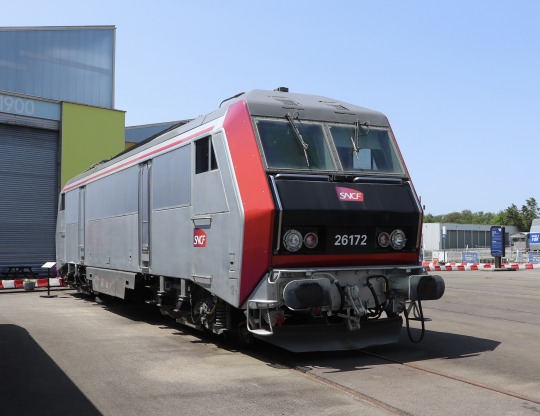
It's from the 1980s, so I guess the first are reaching retirement age. But at the same time: The train I took from Basel to Mulhouse was still pulled by one of these BB-26000.
Other favourites include the BB-25600 with its rare diagonal light arrangement:
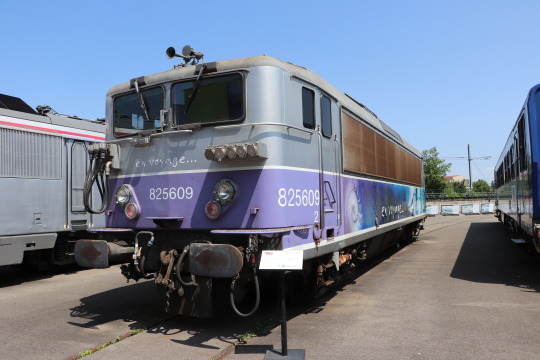
Or the really terribly lit gas turbine train RTG, which puts the headlight on stalks:
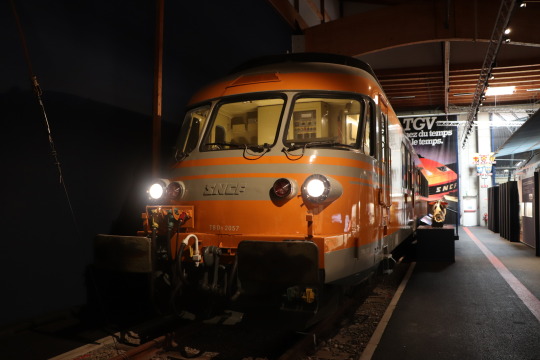
Fun fact: Amtrak did end up buying a few these. They didn't use the same white headlights (although they did use the same stalks), but they did use the same fresnel lens red taillights.
And the headlights went all the way up to the top. To the TGV. Only these headlights aren't very aerodynamic, so for their high-speed train, SNCF decided to cover them up.
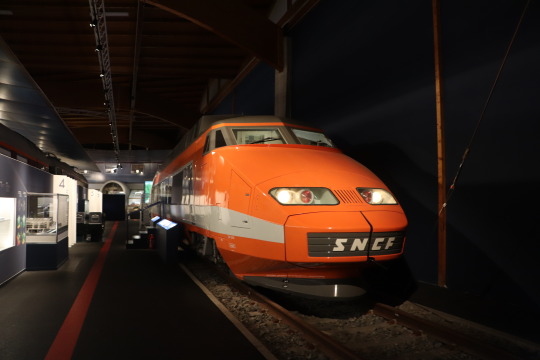
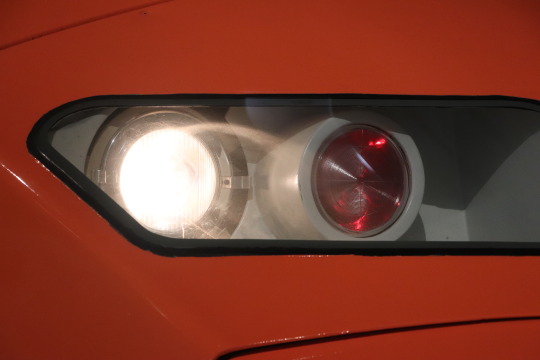
As far as I can tell, SNCF used these headlights in the TGVs up to the Réseau series, including the Eurostar. That meant that they're also found, though behind faded glass, on the TGV Atlantique 325 in the outdoor area. Number 325 is notable because it was involved in another high speed trail, and reached 515.3 km/h (320.3 mph) on May 18th, 1990.

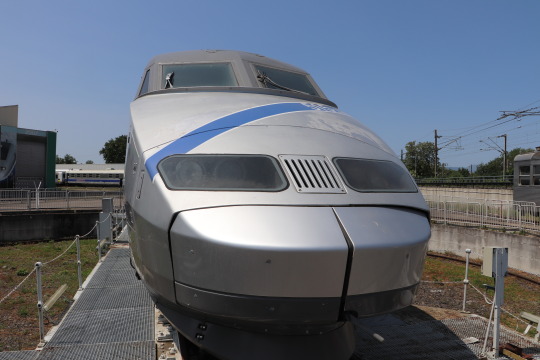

That was a world record, of course; in fact only the French ever exceeded 500 km/h on conventional railroads. So these headlights did get their world record after all. They didn't get to keep it for long, though. In 2007, a newer TGV reached 574.8 km/h (357.2 mph). That one is still in service, though, and it was equipped with newer LED headlights. I think it's highly unlikely that this record will be broken anytime soon, but if anyone does, I wouldn't be surprised if it were the French again, they like that sort of stuff.
Some final odds an ends with the headlights, though: Here's CC-40101, which isn't actually relevant, I just like the way it looks.

Designed for service in France, Belgium, the Netherlands and Germany, with four different voltages and four different train control systems, and that with mid-1960s technology. It wasn't quite as successful as hoped, and in service it only ever reached Belgium, but still, look at that design. The front is supposed to evoke an athlete, a sprinter about to start, but this type of design has instead become known as "Nez cassé", broken nose.
BB-9291 shows a rare early version without red tail lights at all. Someone thought they were saving money.
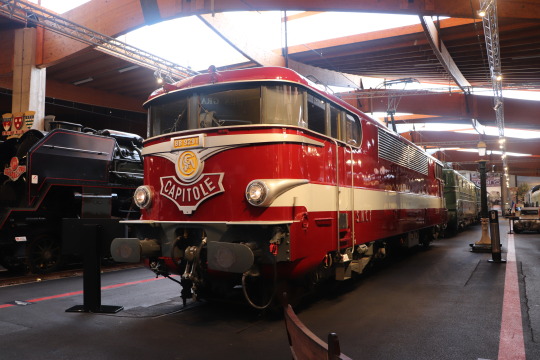
This small work train has a free-standing version of the headlight, which shows us how deep it really is. Apparently, the French headlight is actually not that deep, and isn't that a nice summary for this post?
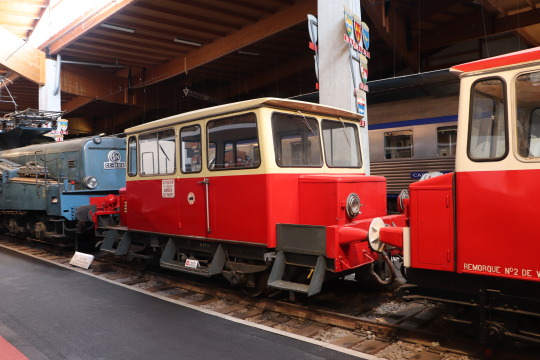
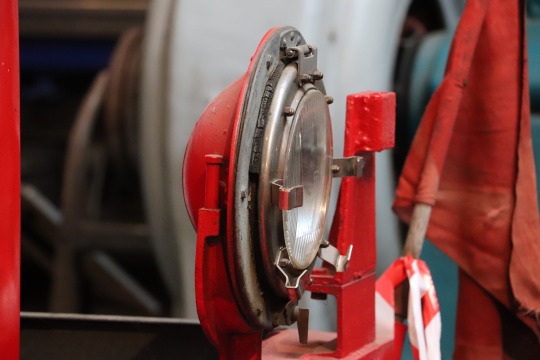
And a personal favourite of mine, I even bought a T-Shirt with it on it, the Z 600:
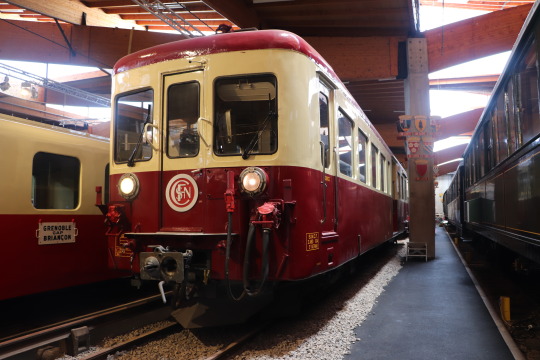
The design, in particular the side windows (recessed instead of flush, no outside visible gasket) says Swiss, the headlight and SNCF logo says French, it's narrow gauge and it has a third rail to provide power. Just all around a weird little train, for the weird little line known as the Mont-Blanc Express from France via Switzerland to the bottom of the Mont-Blanc mountain. The train was built in Switzerland, experts of building small trains for mountains, but for the French part of that rail line, so it got French headlights.
Headlights with exporting is a fun topic in its own right. Do you keep the headlights from the country of origin, or demand your own? You will find both approaches. Both Portugal and the Netherlands bought very similar electric locomotives from France. Portugal has French headlights, the Netherlands insisted on (less interesting) dutch ones.
These days, of course, you will still find these headlights, but they're getting rarer. They stopped being used in new trains around the mid-1990s. What's more, the ones you do find, like on this MI-84 in Paris, probably don't have the fresnel lens taillight anymore. Instead, those were replaced with LEDs.

LED lights for railroads make a lot of sense. They last forever and require less power. And since most railroads have standardised their head- and taillights, you just need to design one replacement light for most of France, and then keep building that one until SNCF stops giving you money.
(Since we're showing a picture from Paris, a quick note: These headlights were never used on passenger-carrying trains for the Paris metro. However, some work trains do have them.)
These days, standard headlights are completely gone. LEDs don't need a lot of replacing, and they give you much more freedom to do things like shapes and patterns and designs. Also, we don't have the "one country, one railroad, one rail industry" pattern anymore. Instead now we have multi-national rail conglomerates. Alstom is technically French, but arguably just as much German, ever since they bought Bombardier's rail division, nominally Canadian. Stadler is Swiss, except for the stuff they build in Germany or Poland or Belarus or Hungary or…, and some of their most interesting products right now are built and designed in Spain.
The end result of that is this:
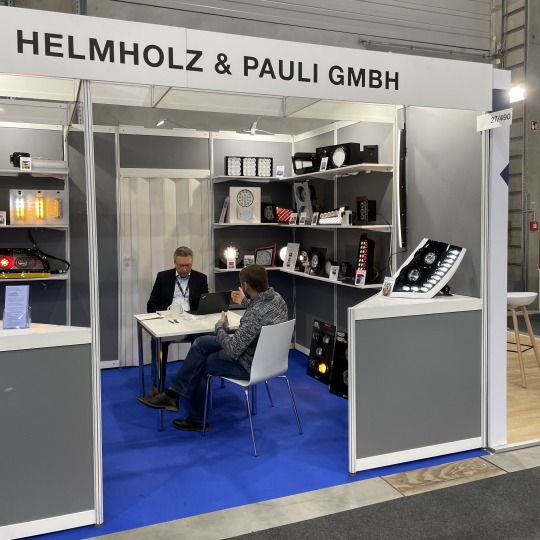
That's a company I saw at a trade fair (Innotrans, Berlin, 2022) that makes LED train headlights, and specifically they make… all of them? Okay, I'm exaggerating, but this is a great picture to drive a European rail fan insane as they try to assign the different headlights to different trains. You get Stuttgart trams, German (and Turkish) high speed trains, lots and lots of Swiss stuff. Nothing specifically French that I could tell, but at least the German high speed train regularly travels to Paris.
The standard headlights, or their LED variants, were still in use for work trains until fairly recently. There are not that many companies that make rail grinders or ballast tampers, and those tend to just use whatever headlight their customer tells them to. But these days they go for shaped LED headlights as well, because they're just better, and because thanks to European standardisation, a headlight approved in one country can (generally) be used in all European countries.
(All pictures © me, feel free to use them under CC-BY-SA 3.0 DE if you want)
55 notes
·
View notes
Text



Today, August 7th, is National Lighthouse Day in the US! The event was established during the bicentennial of when the US government created the US Lighthouse Establishment in 1789.
To kick off a week of lighthouses, we're starting with a book by the National Park Service and the Cabrillo Historical Association about the Old Point Loma Lighthouse (1978), located in San Diego, California. Included here are two pages about how the lighthouse was lit. Image transcripts below the cut.
For more information, check out these links:
National Lighthouse Day history from the US Lighthouse Society
The Lighthouses of Point Loma by the National Park Service
The Old Point Loma Lighthouse in our catalog
The Browne Popular Culture Library (BPCL), founded in 1969, is the most comprehensive archive of its kind in the United States. Our focus and mission is to acquire and preserve research materials on American Popular Culture (post 1876) for curricular and research use. Visit our website at https://www.bgsu.edu/library/pcl.html.
Image caption
Fresnel (fra-nel) lighthouse lenses came in seven different "orders," or sizes; first, second, third, three and a-half, fourth, fifth, and sixth. The first order were the largest, and the sixth the smallest. Generally, the larger the lens the greater its range. The larger lenses could be seen from further away than the smaller ones. Also, if a lens was high above sea level, it could be seen from further away than if it was at the water's edge. The ranges given in the illustration are median distances for a lens with a 1,000 watt bulb.
Lenses and Illuminants
Until the 1850's, nearly every lighthouse in the United States used a number of Argand lamps and parabolic reflectors for illumination. These lamps were placed "side by side around the circumference of a circle," and the number of lamps used depended upon the arc of the horizon it was desired to illuminate. For years a bulls-eye magnifying lens was used on each lamp, but these lenses were practically useless, and in 1840 they were removed, leaving the reflectors.
This system, which had become known as the American system, had but one virtue—the lamps were inexpen-sive. But their faults were legion: They were complicated, they used a vast amount of oil, they required constant attention, and, most important of all, they produced relatively little light.
In 1822 Augustin Fresnel, a French physicist, developed a lens apparatus which was to revolutionize lighthouse illumination. A Fresnel lens is like a glass barrel whose outer surface is made up of prisms and bulls-eyes. In a revolving or flashing light, the bulls-eyes are surrounded by curved, concentric prisms, concentrating the light of a central lamp into several individual beams, radiating like the spokes of a wheel. In the fixed, or steady light, the bulls-eyes become a continuous "lens belt," with the prisms [next page] parallel to it, producing an uninterrupted, horizontal sheet of light. Fresnel lenses were classified into seven orders. The order was determined by focal distance—that is, the distance from the illuminant to the lenses.
The United States was slow to adopt the Fresnel lenses, and for years a controversy raged in this country over the merits of the old and new systems. Finally, in 1841, the United States purchased its first Fresnel lens and installed it at Navesink Light, New Jersey, to test the new system. The Fifth Auditor conducted the experiment with all deliberate speed (the accent being on deliberate); 10 years later there were only three light stations in the country which had Fresnel lenses. On March 3, 1851, Congress expressed confidence in the new system by approving an appropriation bill which included permission for the Secretary of the Treasury to place the Fresnel lens system in new lighthouses, in lighthouses not having lenses, and in lighthouses requiring new ones.
Image caption
In the fall of 1855 craftsmen installed a third order, fixed light lens in the lighthouse lantern. Made in Paris, it stood over five feet high and three feet wide. In the center, a lamp with three circular wicks, one inside the other, produced a flame of 168 candlepower. The finely ground and highly polished prisms, and the bulls-eye that encircled the lens, captured the light from this flame, focused and magnified it to about 19,000 candlepower, and sent it out in a horizontal sheet of light. According to the 1862 edition of the "Directory for the Pacific Coast of the United States," the lens of the Point Loma light which is 462 feet above sea level "illuminates the entire horizon, and in clear weather should be visible—From a mast height of 20 feet above the sea, at a distance of 28 miles."
7 notes
·
View notes
Text

“This has to be the one my PePop used to work in”, She looked up at the old aged lighthouse, the red stripes had peeled off the dirty white 1920s lighthouse exterior. The ocean raging on the cliffside was always the way she’d imagined it. Bonnie had heard stories of her great-grandfather’s time in this place. He recalled the cold damp feeling of the walls, the lense illuminated against the rest of the house, which only came to vision under the light of his oil lamp. “I remember the way he’d described his loneliness here, The ships he’d help guide from the sea from his tower of despair.” She wiped her tears before she snapped the chain that held the lighthouse sealed shut. Her flashlight illuminated the decaying walls covered in graffiti and the floor buried in beer cans. She’d started the approach the rickety staircase that she’d heard PePop describe so many times in her childhood. After shuffling up the narrow stairs, the living quarters where her great-grandfather once lived, the old bedframe was mangled with just the springs left of the mattress. Creeping up to the lens room once described as a heavenly aura, the warm divine glow that beckoned sailors from the sea was now shards of broken glass, mixed with the empty bottles of 1980s Heineken beers. Bonnie picked up a piece of glass from the lens and bright red blood started dripping from her hand. She left her bloody handprint on what was left of the Fresnel Lens. The moment she stumbled onto the deck of the lighthouse the persistent ocean breeze called her name as she knew it would.
2 notes
·
View notes
Text
Three years and five referrals later, I think I am finally actually on the waiting list for strabismus surgery!
The journey so far:
1. Notice your weird eye thing is happening more frequently. Do some research and learn it has a name - strabismus. Ask for a referral to an ophthalmologist next time you’re at the walk-in clinic getting your meds refilled
2. The walk-in clinic sends the referral, but it’s rejected because you have to go ask an optometrist about it first. You go to an optometrist. She says she can help, but recommends something called “vision therapy” and gives you bifocals. You do some research and discover that vision therapy is only supported by evidence for a specific manifestation of strabismus that is clearly not what you have. It is also not covered by your insurance and is very expensive. You tell her no thanks but wear the bifocals because she told you to. They do not help.
3. You go back to the walk in clinic and say you saw an optometrist and she didn’t help, and you would like a referral to an ophthalmologist. They agree and send the referral
4. You wait a number of months and get no response. You call the walk-in clinic and ask about the referral. “What referral?” they say. They have lost the referral. You go back to the walk-in clinic and get another referral.
5. The referral comes through and you have an appointment with an ophthalmologist! He tells you he isn’t really an expert in strabismus and refers you to someone else who is.
6. Your referral to the other ophthalmologist goes through. He tells you the bifocals are doing nothing and you can stop wearing them, and gives you a fresnel prism to wear. This is a plastic sticker that goes over one lens. It compensates for your double vision, but also makes that eye extremely blurry. He says he can put you on the waiting list for surgery.
7. You wait to hear about surgery but hear nothing. A few months after you were told you’d hear something, you call the office. They tell you the ophthalmologist has moved to Ontario and all his patients have been referred to other people. You want to scream.
8. About a year after getting the fresnel prism you give up and get prisms built into your glasses instead. It’s expensive, but helps a lot. Not completely though, and you’re at the maximum they can possibly do to compensate for your strabismus.
9. At some point you call the new ophthalmologist’s office to ask how long this referral will take. They tell you that they mostly see children, so it may be 2 or more years. They believe they are the only ophthalmologist in the area dealing with strabismus. You wish doctors had caught this when you were a kid instead of assuming you’d grow out of it.
9. Eventually, something like 3 years after going to the walk in clinic, you get in to see the new ophthalmologist on a cancellation without having to wait the 2 years for the referral. You are put on the surgery list. Again. One of the techs tells you it’s impressive that your glasses can fit so much prism in them and be actually wearable. You hope this time you will have surgery and your ophthalmologist will not move away.
#It was very fun when the people at the ophthalmology office asked about my history with strabismus#They kept asking ''Oh is this where you were referred to us?'' and I was like ''Nope. Not yet''#Anyway crossing my fingers it works this time#strabismus#The ''best'' part is strabismus surgery has kind of mediocre success rates so I may end up needing a revision anyway
3 notes
·
View notes
Text

Book on Chair.
Intrepid 4x5 Black Edition, Rodenstock Geronar 150mm 1:6.3, Copal 0 + LomoGraflok + Fujifilm Instax Wide Instant Film
A test of sorts. I recently added the Intrepid 4x5 focus hood to my LF kit. It comes with a fresnel screen. Nifty little gizmo.
I wear glasses. Using a loupe with the hood is impossible. But I found that holding a magnifying glass up to the back edge of the hood gives me a good close-up view of the screen and is a big help with focusing the camera.
In this shot, the main focus was the dot on the cover, plus I added just a touch of tilt. Hardly noticeable.
Looking forward to getting out a bit with this rig.
I'm still making my way through Rubin's book. Brilliance at every page turn.
#4x5#color#film#focushood#fresnel#fuji#fujifilm#fujifilmwide#instantfun#instant#instantfilm#instax#intrepid#integral#largeformat#largeformatphotography#lomograflok#photography#play#wide
3 notes
·
View notes
Text

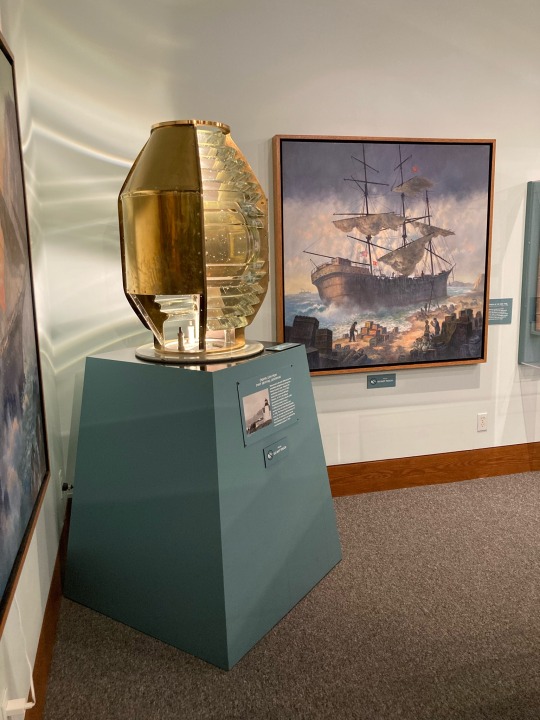
stained glass and Fresnel lens
San Mateo County History Museum
4 notes
·
View notes
Note
🔮🐸✏️
🔮 What’s your dream job?
honestly I think if I worked as a props manager I would be absolutely at home. finding objects, cataloging and categorizing objects, fighting with actors....living the dream tbh. that or making a career out of improv. i would love to play pretend with friends as a job.
🐸 Describe your aesthetic.
like if a woodcut picture of a bowl of fruit, a fresnel lens, and a stained glass window had a wild night out with a jean jacket and two months later the Jean jacket calls with some news and nobody knows who the father is
✏️ Have you ever written fanfiction?
is the sky blue is grass green. am I gay, etc
1 note
·
View note
Text
youtube
The second example of stylized glass is from Blender Manong's tutorial.
Pros: still easy to use
Cons: same problems with solidify and light specks
Overall: still 7/10
Very similar to the previous tutorial test, but this time with MixShader instead of MixRGB for tying the main gradient and the light specks together, and with Fresnel node instead of LayerWeight. There are no significant differences between these nodes for the glass shader, so it's up to your preferences.

Also, on a sphere it gives only one light speck:
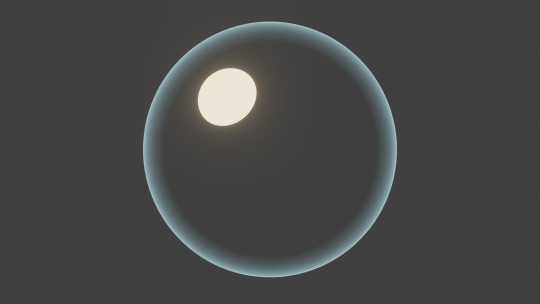
But has much better reaction to the holes and gaps:

Hooray.
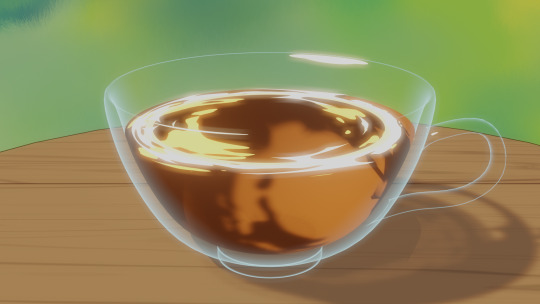
0 notes
Text
Mirror Mirror, a Colorful Interactive Art Installation
This vibrant public art installation utilized interactive fresnel lenses to create dynamic, colorful experiences for people that interacted with it.
Located in a public square in Alexandria, Virginia, the multi-colored exhibit featured glass prisms that responded to both movement and sound, making it fun and exciting to interact with.
Created by SOFTlab, a New York based interactive group, the…

View On WordPress
0 notes
Text
Events 1.15 (before 1940)
69 – Otho seizes power in Rome, proclaiming himself Emperor of Rome, beginning a reign of only three months.
1541 – King Francis I of France gives Jean-François Roberval a commission to settle the province of New France (Canada) and provide for the spread of the "Holy Catholic faith".
1559 – Elizabeth I is crowned Queen of England and Ireland in Westminster Abbey, London.
1582 – Truce of Yam-Zapolsky: Russia cedes Livonia to the Polish–Lithuanian Commonwealth.
1759 – The British Museum opens to the public.
1777 – American Revolutionary War: New Connecticut (present-day Vermont) declares its independence.
1782 – Superintendent of Finance Robert Morris addresses the U.S. Congress to recommend establishment of a national mint and decimal coinage.
1815 – War of 1812: American frigate USS President, commanded by Commodore Stephen Decatur, is captured by a squadron of four British frigates.
1818 – A paper by David Brewster is read to the Royal Society, belatedly announcing his discovery of what we now call the biaxial class of doubly-refracting crystals. On the same day, Augustin-Jean Fresnel signs a "supplement" (submitted four days later) on reflection of polarized light.
1822 – Greek War of Independence: Demetrios Ypsilantis is elected president of the legislative assembly.
1865 – American Civil War: Fort Fisher in North Carolina falls to the Union, thus cutting off the last major seaport of the Confederacy.
1867 – Forty people die when ice covering the boating lake at Regent's Park, London, collapses.
1870 – A political cartoon for the first time symbolizes the Democratic Party with a donkey ("A Live Jackass Kicking a Dead Lion" by Thomas Nast for Harper's Weekly).
1876 – The first newspaper in Afrikaans, Die Afrikaanse Patriot, is published in Paarl.
1889 – The Coca-Cola Company, then known as the Pemberton Medicine Company, is incorporated in Atlanta.
1892 – James Naismith publishes the rules of basketball.
1908 – The Alpha Kappa Alpha sorority becomes the first Greek-letter organization founded and established by African American college women.
1910 – Construction ends on the Buffalo Bill Dam in Wyoming, United States, which was the highest dam in the world at the time, at 99 m (325 ft).
1911 – Palestinian Arabic-language Falastin newspaper founded.
1919 – Rosa Luxemburg and Karl Liebknecht, two of the most prominent communists in Germany, are clubbed and then shot to death by members of the Freikorps at the end of the Spartacist uprising.
1919 – Great Molasses Flood: A wave of molasses released from an exploding storage tank sweeps through Boston, Massachusetts, killing 21 and injuring 150.
1934 – The 8.0 Mw Nepal–Bihar earthquake strikes Nepal and Bihar with a maximum Mercalli intensity of XI (Extreme), killing an estimated 6,000–10,700 people.
1936 – The first building to be completely covered in glass, built for the Owens-Illinois Glass Company, is completed in Toledo, Ohio.
1937 – Spanish Civil War: Nationalists and Republicans both withdraw after suffering heavy losses, ending the Second Battle of the Corunna Road.
0 notes
Text
There are people in this world who will stand up and shout, "SEE? PROOF THE (name an ancient civilization from thousands of years ago) COULD MELT ROCKS WITH SUN LASERS!!"
And I'm like, "Uh, you DO know that the lens he uses is a Fresnel lense made of modern materials with modern machining precision, right? Not only that, it's a GIANT Fresnel lens which costs quite a lot of money, and requires FAR more precision than the business card version I keep in my wallet to help me read tiny print, right??"
Yes, ancient civilizations could and did make precision circles--it's not that difficult if you have a pivoting fulcrum point! But the materials aren't showing up anywhere in the archaeological record. No rock crystal is going to be that clear and flawless, and in the time periods described, no glass was clear enough, let alone moulded or carved with that much precision.
0 notes